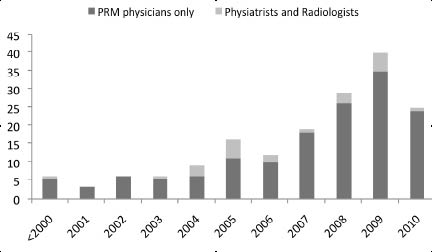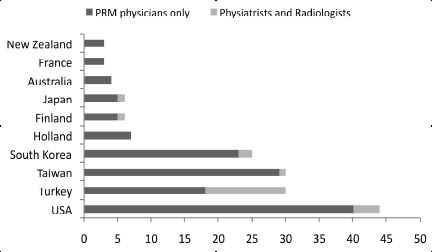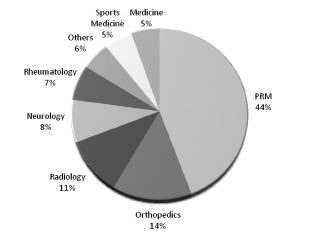Alper Murat Ulaşlı, MD1, Murat Kara, MD2 and Levent Özçakar, MD3
From the 1Ankara Training and Research Hospital Department of Physical Medicine and Rehabilitation, 2Ankara Physical Medicine and Rehabilitation Education and Research Hospital and 3Hacettepe University Medical School Department of Physical Medicine and Rehabilitation, Ankara, Turkey
OBJECTIVE: Interest in the use of musculoskeletal ultrasonography in the field of Physical and Rehabilitation Medicine has increased significantly over recent years. In order to determine to what extent this growing interest among Physical and Rehabilitation Medicine physicians is resulting in publications, we reviewed the trend in publications by physiatrists on musculoskeletal ultrasonography.
METHODS: We searched retrospectively for all papers indexed in Science Citation Index-Expanded and Index Medicus in which “rehabilitation medicine” was addressed as at least one of the authors’ affiliations (up to 2011). All papers were examined individually for the authors’ affiliations, document types, publication years, countries, and journal categories.
RESULTS: A total of 171 papers was included in the study. After 2004, there appears to be a significant amount of increase in the number of publications. USA, Turkey, Taiwan and South Korea were the leading countries in which physiatrists carry out research and publish papers on musculoskeletal ultrasonography. The top 5 journal categories in which these papers were published were: Rehabilitation (44.3%), Orthopaedics (14.1%), Radiology (10.7%), Neurology (8.1%) and Rheumatology (6.7%).
CONCLUSION: The number of scientific publications by physiatrists about musculoskeletal ultrasonography is increasing in parallel with the interest regarding its routine use in Physical and Rehabilitation Medicine clinics.
Key words: musculoskeletal ultrasound; physiatrist; publication.
J Rehab Med 2011; 00: 00–00
Correspondence address: Murat Kara, Ankara Fizik Tedavi ve Rehabilitasyon Eğitim ve Araştırma Hastanesi, Türkocağı sok. No: 3 Sıhhıye, Ankara, Turkey. E-mail: mkaraftr@yahoo.com
Submitted February 14, 2011; accepted May 5, 2011
INTRODUCTION
Due to the various advantages of musculoskeletal ultrasonography (MSUS) (i.e. inexpensive, non-invasive, easily accessible, does not involve radiation, provides comparative real-time imaging during dynamic manoeuvres) it is increasingly used as a convenient imaging tool in the diagnosis of a wide range of musculoskeletal disorders (1). Interest in its use in the field of Physical and Rehabilitation Medicine (PRM) physicians has therefore increased. We have reported previously on the perceptions of PRM physicians regarding MSUS, and the current utilization (or barriers to implementation) of MSUS in clinical practice (2). However, data is lacking as to whether this increasing interest in, and use of, MSUS among PRM physicians is resulting in increased numbers of publications.
The aim of this review was to perform a comprehensive search of major indexing databases in order to determine the current status of scientific publication by PRM physicianson MSUS.
METHODS
The Science Citation Index-Expanded (SCI-Exp) and Index Medicus (PUBMED) were searched retrospectively for all papers indexed in which “rehabilitation medicine” was addressed as at least one of the authors’ affiliations. For this purpose, ISI Web of Knowledge®–Web of Science® software and PUBMED, which are updated regularly, were used.
The search terms used in the topic section of the ISI Web of Knowledge®–Web of Science® software were “muscle ultrasonography, musculoskeletal ultrasonography, nerve ultrasonography and joint ultrasonography”, and in the address section “rehabil”, using the general search function (31 December 2010).
A search of PUBMED was performed using the key words “muscle ultrasonography and rehabilitation”, “musculoskeletal ultrasonography and rehabilitation”, “nerve ultrasonography and rehabilitation” and “joint ultrasonography and rehabilitation”.
All papers were examined individually for the authors’ affiliations, document types, publication years, countries, and journal categories. In addition, each paper was categorized according to the person who had performed the MSUS evaluations (as mentioned in their methods). In cases in which a specific person was not mentioned, if there was a radiologist among the authors that individual paper was categorized as a publication by radiologists. Those papers in which all the authors were allied health professionals working in rehabilitation sciences, but not PRM physicians, were excluded.
Statistical Package for the Social Sciences (SPSS®) version 15.0 software was used to analyse the results with regard to the number of publications per year, journal category and country.
RESULTS
A total of 171 papers was included in the study. The article types are shown in Table I. Fig. 1 illustrates the distribution of papers according to year of publication. After 2004 there is a significant increase in the number of publications. Fig. 2 shows the top 10 countries. The journal categories in which these papers (authored by PRM physicians only) had been published are shown in Fig. 3.
| Table I. Number and types of papers about musculoskeletal ultrasound |
| Document type | Physiatrists only n | Physiatrists and radiologists n |
| Article | 139 | 160 |
| Case report | 6 | 7 |
| Review | 4 | 4 |
Fig. 1. Distribution of papers according to year of publication.
Fig. 2. The top 10 countries publishing papers on musculoskeletal ultrasound.
Fig. 3. Journal categories in which the musculoskeletal ultrasound articles were published. PRM: Physical and Rehabilitation Medicine.
DISCUSSION
The aim of this review was to provide an overview of the MSUS publications of PRM physicians. In particular, the objective was to determine to what extent the increasing interest of PRM physicians in MSUS was reflected in scientific research. Our results indicate that the number of MSUS publications has increased greatly over the last decade; we found 6 publications prior to 2001, and 165 between 2001 and 2011.
The use of ultrasound (US) in medicine is increasing rapidly, and it is currently an integral tool in multiple non-radiological specialties, including emergency medicine, obstetrics and gynaecology, anaesthesiology, neurology, general surgery, endocrinology, PRM, rheumatology, sports medicine, paediatrics and family medicine (3). While many physicians focus their sonographic efforts on interventional guidance to improve accuracy, US is an ideally well-suited, cost-effective imaging modality for the evaluation of various neuromusculoskeletal structures (2). In addition, in parallel with the advance in US technology over years, MSUS has become an important complementary and, in some cases, alternative tool to magnetic resonance imaging for several musculoskeletal pathologies (1, 4, 5). The industrial evolution of new-generation machines and probe quality, along with the use of power Doppler techniques has made a great contribution in the field of MSUS, not only in general, but also in inflammatory musculoskeletal diseases.
Likewise, in a previous study, we showed that the use of MSUS in PRM clinics provides a significant advantage in terms of time and cost (1). In addition, MSUS provides the opportunity to quantify the dimensions of several musculoskeletal structures that might otherwise not be readily available (6–12).
We found very few publications prior to 2000. The number increased thereafter, and a critical rise ensued in 2005. Although this increase can be attributed to the recognition of advances in US technology and the adoption of this new trend; we believe that the delay is due mainly to difficulty in obtaining access to US. However, in a previous study, we reported that two important barriers to implementation of MSUS were a lack of devices and education (2). The latter problem is overcome by the increasing number of courses and seminars available at various national and international meetings (2, 13); however, obtaining funding for equipment remains a problem for PRM physicians.
Overall, the USA, Turkey, Taiwan and South Korea were the leading countries in which PRM physicians carry out research and publish papers on MSUS. We believe that the differences between the countries stem from the individual interests of PRM physicians. As different US machines were used in those countries, we cannot comment on whether those PRM physicians had greater access to US.
Concerning the journal categories, the papers were most commonly published in PRM journals, which is further proof that our society is aware of the growing interest in MSUS. In addition, organizations have been established to foster the academic strength of PRM physicians sonographers, e.g. TURK-MUSKULUS (http://www.turk-musculus.org/) and EURO-MUSCULUS (http://www.euro-musculus.org/).
In conclusion, this paper provides an overview of the scientific publications of PRM physicians with respect to MSUS. The number of publications is increasing in parallel with the growth in interest regarding the use of MSUS in daily practice in PRM clinics. As the number of such articles increases, it will be of interest to analyse their citations and topic distribution.
REFERENCES





